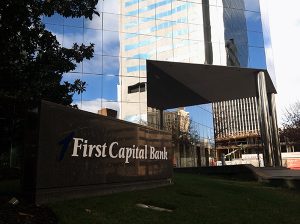
First Capital Bank’s downtown branch at 901 E. Cary. (Photo by Michael Schwartz)
The stabilization of the Richmond banking scene continued in 2013 as more local banks found their way into the black while continuing the shed the weighty baggage from the real estate downturn.
All but two of the 14 community banks headquartered in the Richmond market turned a full-year’s profit in 2013, according to their year-end financial filings. In 2012, there were still four banks trying to find their way back to profitability.
Perhaps the brightest spot was the decline in local banks’ levels of nonperforming assets, a figure that includes foreclosed real estate and soured loans.
Twelve of the 14 local banks saw their levels of troubled loans and nonperforming assets drop in 2013 compared to the previous year. Those assets have been the main cause for losses at banks in recent years coming out of the recession.
The 14 banks reported a combined $205 million of such assets in 2013. That’s down from $263 million in 2012. Those figures include past due and nonaccrual loans for the handful of local banks that file only with the FDIC.
Another trend that has some bankers optimistic was an uptick in loan demand during the year.
“I would characterize loan demand as still relatively tepid,” said Gaylon Layfield, chief executive of Xenith Bank. “But it’s certainly stronger than what we saw in ‘10 and ‘11.”
Ten of the market’s 14 locally based banks grew their loan portfolios in 2013. Xenith had the largest increase among its local peers for the year, growing its loan portfolio by $154.1 million during 2013 to $533 million.
While a chunk of that increase came from buying into a federally guaranteed student-loan program, Layfield said commercial real estate lending also heated up.
“We have certainly seen some pick up in commercial real estate activity,” he said, adding that there’s been particular strength in the multifamily market for apartment loans and a modest pickup in loans for single-family residential development.
First Capital Bank saw a solid rise in its loan portfolio, growing $54.25 million to $423 million at the end of the year. And the parent companies of Essex Bank, Franklin Federal Savings Bank, Bank of Virginia, Union First Market Bank and C&F Bank each reported eight-figure increases in their loan portfolios for the year.
The scent of loan demand also continued to draw revenue-hungry out-of-town banks to the market.
“Competition has intensified a lot,” said Rick Wheeler, chief executive of Franklin Federal Savings Bank. “Banks that haven’t been as successful as we have been over the last several years have gotten mighty hungry. Terms have liberalized a whole lot.”
Franklin Federal grew its loan portfolio by $60.72 million during its fiscal year 2013. That growth showed the bank is staying active despite having the highest level of NPAs in the market at $55.8 million at its year end. That was its highest level since 2011.
Among the leaders in profit for the year, Union First Market Bank and its parent company far outpaced the rest of the field. Its $34.49 million in net income for 2013 was more than double its nearest local rival, C&F Bank parent company C&F Financial at $14 million.
Essex Bank, Franklin Federal, First Capital, Bank of Virginia, Bank of McKenney and New Horizon each reported higher levels of profit in 2013 compared to 2012.
Only the parent companies of Village Bank and EVB reported losses for the year. Village continues to work its way out of trouble from bad loans centered largely around Chesterfield County.
EVB’s losses were fueled by a large payoff of Federal Home Loan Bank debt.
Correction/clarification: A previous version of this story incorrectly stated that New Horizon Bank had an increase in its nonperforming assets in 2013. The bank’s increase was in fact in its past due and nonaccrual loans as listed in FDIC call reports. That measurement was used in this article to assess the handful of local banks that do not file financials with the SEC. New Horizon saw a drop in those assets defined specifically as nonperforming.

First Capital Bank’s downtown branch at 901 E. Cary. (Photo by Michael Schwartz)
The stabilization of the Richmond banking scene continued in 2013 as more local banks found their way into the black while continuing the shed the weighty baggage from the real estate downturn.
All but two of the 14 community banks headquartered in the Richmond market turned a full-year’s profit in 2013, according to their year-end financial filings. In 2012, there were still four banks trying to find their way back to profitability.
Perhaps the brightest spot was the decline in local banks’ levels of nonperforming assets, a figure that includes foreclosed real estate and soured loans.
Twelve of the 14 local banks saw their levels of troubled loans and nonperforming assets drop in 2013 compared to the previous year. Those assets have been the main cause for losses at banks in recent years coming out of the recession.
The 14 banks reported a combined $205 million of such assets in 2013. That’s down from $263 million in 2012. Those figures include past due and nonaccrual loans for the handful of local banks that file only with the FDIC.
Another trend that has some bankers optimistic was an uptick in loan demand during the year.
“I would characterize loan demand as still relatively tepid,” said Gaylon Layfield, chief executive of Xenith Bank. “But it’s certainly stronger than what we saw in ‘10 and ‘11.”
Ten of the market’s 14 locally based banks grew their loan portfolios in 2013. Xenith had the largest increase among its local peers for the year, growing its loan portfolio by $154.1 million during 2013 to $533 million.
While a chunk of that increase came from buying into a federally guaranteed student-loan program, Layfield said commercial real estate lending also heated up.
“We have certainly seen some pick up in commercial real estate activity,” he said, adding that there’s been particular strength in the multifamily market for apartment loans and a modest pickup in loans for single-family residential development.
First Capital Bank saw a solid rise in its loan portfolio, growing $54.25 million to $423 million at the end of the year. And the parent companies of Essex Bank, Franklin Federal Savings Bank, Bank of Virginia, Union First Market Bank and C&F Bank each reported eight-figure increases in their loan portfolios for the year.
The scent of loan demand also continued to draw revenue-hungry out-of-town banks to the market.
“Competition has intensified a lot,” said Rick Wheeler, chief executive of Franklin Federal Savings Bank. “Banks that haven’t been as successful as we have been over the last several years have gotten mighty hungry. Terms have liberalized a whole lot.”
Franklin Federal grew its loan portfolio by $60.72 million during its fiscal year 2013. That growth showed the bank is staying active despite having the highest level of NPAs in the market at $55.8 million at its year end. That was its highest level since 2011.
Among the leaders in profit for the year, Union First Market Bank and its parent company far outpaced the rest of the field. Its $34.49 million in net income for 2013 was more than double its nearest local rival, C&F Bank parent company C&F Financial at $14 million.
Essex Bank, Franklin Federal, First Capital, Bank of Virginia, Bank of McKenney and New Horizon each reported higher levels of profit in 2013 compared to 2012.
Only the parent companies of Village Bank and EVB reported losses for the year. Village continues to work its way out of trouble from bad loans centered largely around Chesterfield County.
EVB’s losses were fueled by a large payoff of Federal Home Loan Bank debt.
Correction/clarification: A previous version of this story incorrectly stated that New Horizon Bank had an increase in its nonperforming assets in 2013. The bank’s increase was in fact in its past due and nonaccrual loans as listed in FDIC call reports. That measurement was used in this article to assess the handful of local banks that do not file financials with the SEC. New Horizon saw a drop in those assets defined specifically as nonperforming.

Actually, there are numerous small business owners that would love to borrow but can’t. These business owners have been in business for years, have strong track records, sound business practices adn provide a much needed service to our community and those throughout the county. They are revitalizing communities where they go, increasing values, decreasing crime and reducing or eliminating blight. Unfortunately, due to banking reg’s implemented over the past few year, it has become extremely difficult to borrow in the conventional sense. Many of these fine people have had to resort to lenders charging high interest rates, some as high… Read more »